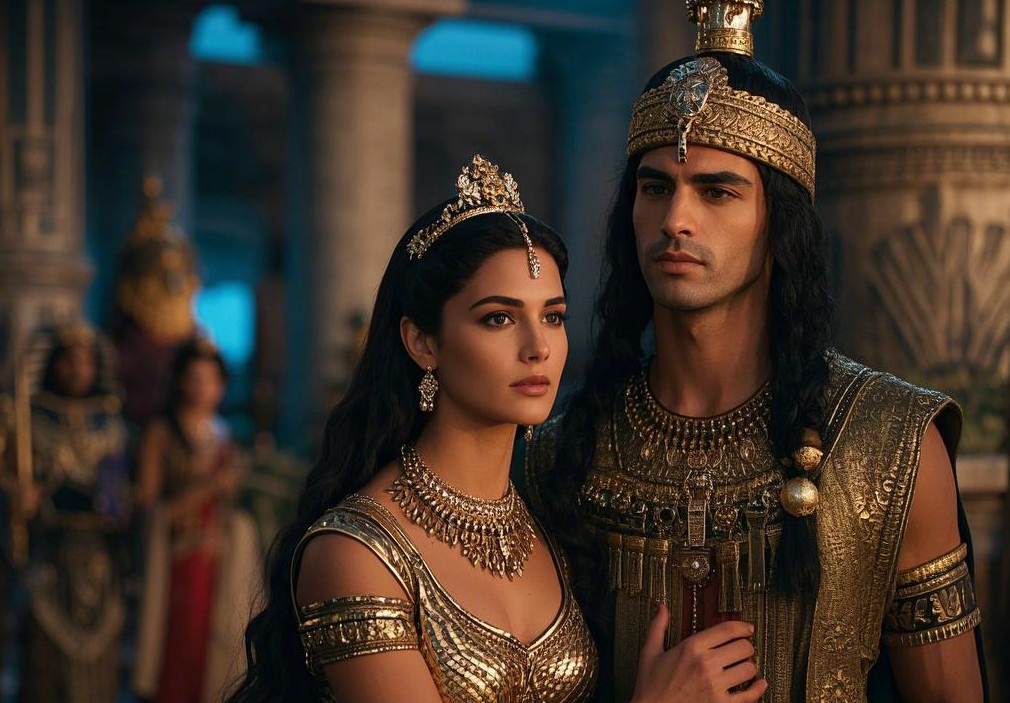Sands of Love: An Egyptian Odyssey
In the heart of ancient Egypt, where the mighty Nile flowed through a land of mystery and splendor, a tale of love was about to be woven into the annals of history.
Thebes, the capital of the New Kingdom, was a bustling metropolis filled with the grandeur of pharaonic rule. The Temple of Karnak stood as a testament to the power of the gods and the might of the pharaohs. Amidst the priests, scribes, and artisans, there was a young woman named Ishtar.
Ishtar was a priestess - in - training at the Temple of Hathor, the goddess of love, beauty, and music. Her skin was like burnished copper, and her eyes, a deep almond - shaped brown, held a world of secrets and dreams. Her long, jet - black hair was often adorned with lotus flowers, a symbol of purity and rebirth. Ishtar spent her days learning the ancient rituals, chanting hymns, and studying the sacred texts.
One fateful day, a young prince named Ramses returned from a military campaign. Ramses was the son of the pharaoh, a warrior - hero with a chiseled face and a physique honed by battle. His eyes, a piercing blue - green, were filled with a sense of duty and a thirst for adventure. As was customary, he visited the Temple of Karnak to offer sacrifices and give thanks to the gods for his safe return.
Ishtar was among the priestesses who attended to the prince during his visit. The moment their eyes met, it was as if a spark had ignited in the still air of the temple. Ramses was immediately drawn to Ishtar's grace and the gentle wisdom that seemed to radiate from her. Ishtar, in turn, was intrigued by the prince's courage and the kindness that she saw beneath his warrior exterior.
Over the next few weeks, Ramses found excuses to visit the temple more often. They would steal moments to talk in the quiet corners of the temple gardens, surrounded by the scent of blooming flowers and the sound of the nearby Nile. Ishtar would share with Ramses the stories of the gods and the ancient wisdom of the temple, while Ramses would tell her of his adventures on the battlefield and his dreams for the future of Egypt.
However, their budding romance was soon met with resistance. The pharaoh had grand plans for Ramses' future, and a marriage to a foreign princess was being arranged to strengthen Egypt's political alliances. The high priests of the temple also disapproved of the relationship, as they believed that a priestess should remain devoted solely to the service of the gods.
Ishtar was heartbroken. She knew that the weight of tradition and duty was heavy upon them. But Ramses was determined not to let go of their love. He decided to prove to his father and the priests that Ishtar was not only a worthy partner but also someone who could bring great benefit to Egypt.
Ramses proposed a plan to the pharaoh. He suggested that Ishtar, with her knowledge of the temple's secrets and her connection to the gods, could help in a crucial diplomatic mission. A neighboring kingdom was threatening to cut off trade routes, and Ramses believed that Ishtar could use her spiritual influence to broker peace.
The pharaoh, after much deliberation, agreed to give Ishtar a chance. Ishtar, despite her fear, accepted the challenge. She journeyed to the neighboring kingdom with Ramses and a small entourage. Using her charm, wisdom, and the power of the goddess Hathor, she managed to convince the foreign king to reopen the trade routes and sign a peace treaty.
Upon their return to Egypt, Ishtar was hailed as a hero. The pharaoh was impressed by her capabilities, and the high priests could no longer deny her worth. With the new - found respect and approval, Ramses and Ishtar were finally allowed to be together.
Their wedding was a magnificent celebration, attended by nobles, priests, and commoners alike. The festivities lasted for days, with music, dancing, and feasts. As Ramses and Ishtar looked out over the Nile on their wedding day, they knew that their love had overcome great odds.

In the years that followed, Ramses ascended to the throne, and Ishtar stood by his side as queen. Together, they ruled Egypt with justice and compassion, their love story becoming an inspiration to all who lived in the land of the pharaohs. Their legacy was written in the sands of time, a testament to the power of love to overcome even the most formidable obstacles in the ancient world of Egypt.